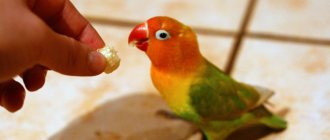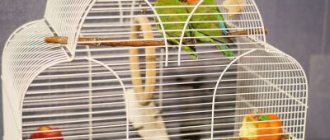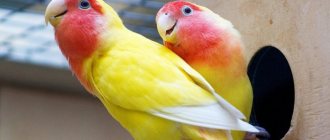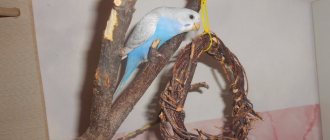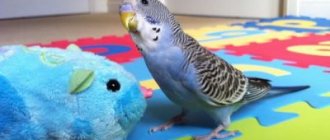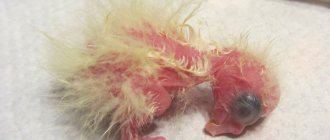Lovebirds are beautiful birds with bright plumage. At home, they are kept in twos, thereby facilitating the task of reproduction. Caring for lovebirds is easy, but during puberty and choosing a mate, some novice poultry farmers face certain difficulties that are worth knowing about (for example, how to breed lovebirds at home or how many days do female lovebirds hatch eggs).
How to choose healthy parents for the future offspring of lovebirds
Individuals older than 1 year are suitable for reproduction. Birds should have a good appetite and healthy, clean plumage. Examine the eyes and beak: there should be no discharge. Birds must be mentally healthy, not rush around the cage and not twitch from any rustle. An aggressive lovebird can peck a female during courtship.
Any physical abnormalities - a drooping wing, lameness, bald spots - become a reason for rejection. An external examination cannot guarantee the complete health of an individual. Before a couple is placed together, it is necessary to be tested for the main types of parasites and common avian infections.
First, it is better to purchase a male and place him in a cage, then add a female to him. If the feathered owner is the first to inhabit the cage, then she may not allow the gentleman into her territory at all. If the owner sees that the male lovebird has pecked his girlfriend, it means that he is not ready to be a neighbor. It is better to put them in different cages and place them side by side. Over time, the birds will get to know and get used to each other. In a month you can move them together.
If they take a pair, they buy them in different places so that the pets do not end up from the same litter. At home, lovebirds are moved into a new cage. Going through a period of adaptation together in a new place, they will become friends.
Two houses
For a couple of lovebirds, two perches are equipped so that they can safely fly from one to another. There should be as much space as possible - from sixty centimeters both horizontally and vertically.
Remember, you cannot serve different foods from the same container. You need at least two sets for the grain mixture, wet food and drinking bowl. Change the water to fresh water daily and check the containers carefully. Perhaps there is only husks instead of food, and the water is polluted.
Age of feathered parents
This indicator is very important for breeding a pair of lovebirds without the help of an ornithologist at home. If the birds' plumage is faded and there is a clearly defined black spot near the beak, they are no more than 2 months old.
The first molt begins at 4–6 months from the frontal part of the head. The next period will begin in a year, after which it is almost impossible to determine the age of the bird.
At 9 months, the reproductive system of lovebirds is fully formed, but they are not yet ready to reproduce. The barely grown chicks themselves will not yet be able to properly care for their offspring. Young parents and their brood are more likely to become ill, leading to mortality.
When lovebirds are one year old, they are completely ready to breed. Up to 4 years old birds retain the ability to give birth to healthy offspring.
Preparing parrots for breeding
Birds aged from 1-1.5 to 3-4 years are selected for breeding. Younger or older individuals usually produce weak and non-viable offspring. Future breeders should be healthy, active, with clean and shiny plumage. Shy, aggressive and sick individuals, as well as parrots that are related to each other, are not allowed for breeding. In addition, the birds should not be in a state of molting.
Lovebirds can be planted at any time of the year, but the most favorable periods for hatching chicks are considered to be February-May and August-October. Chicks born in winter and summer are often weak and sick.
Lovebirds choose a partner for life, so difficulties may arise when forming a pair. It is recommended to put several birds in one cage and let the pairs form on their own. If this is not possible, the male and female are first kept together for 1 week and then placed in separate cages for 2 weeks. After this, the parrots are seated again; Usually in this case they form a pair.
For successful breeding, the air temperature in the room must be maintained at 18-20°C and humidity at 50-60%. The duration of daylight should be at least 15 hours.
The diet of future producers is enriched with fresh vegetables, fruits, herbs, sprouted grains, animal products (boiled eggs, cottage cheese, insects and their larvae), vitamin and mineral supplements. It is useful to add honey (2 g per day) and lemon juice (3 drops per day) to food or water.
The cage where the couple lives is equipped with a special house in which the birds will build a nest. Its dimensions are 17x17x25 cm, the diameter of the taphole is 5 cm. Holes with a diameter of 8 mm are drilled in the bottom for ventilation. Several branches of linden, willow, birch and other deciduous trees are placed in the house, which are first doused with boiling water; the rest of the building material is suspended from the bars of the cage. The female builds a nest within 2-3 weeks, after which mating occurs.
Excess weight
Lovebirds have a tendency to become obese. This disease disrupts the functioning of the bird’s internal organs; such individuals are not inclined to nest. Before mating, the birds are put on a rice diet for 7 days. It includes rice porridge with water, greens, and sprouted grains. It is recommended to open the cage more often to allow the birds to fly around the room. This way they train the heart muscle and lose excess weight.
After a week of dietary nutrition, fruits and vegetables are introduced into the diet. You shouldn’t lose weight too much, especially for females. They may not survive the entire nesting period, and problems with egg laying will begin.
Matching
Most bird species can mate with different individuals during their lives. But not lovebirds. Usually they choose a soul mate for life, and therefore know perfectly well what they want. The breeder faces the real problem of determining the bird's likes and dislikes.
In an already established flock of young animals, it is better to select those who sit side by side, look after each other, pluck feathers, and chirp among themselves. Apparently, these people have already decided on their sympathies.
To do this, before purchasing, I advise you to watch the birds for a couple of hours. Otherwise, you may never expect offspring from your wards, having selected two individuals of the same gender.
Birds from the same brood or family
A pair of birds must be purchased from different nurseries or from different breeders. Parrots that are close in blood cannot become parents of full-fledged offspring. This can lead to various complications:
- empty, unfertilized eggs;
- small masonry;
- poor survival of offspring;
- external defects in chicks.
On a note. Close relationships are used for breeding birds and obtaining new shades of plumage. This method is not suitable for crossing lovebirds at home.
Lifestyle and behavior
The habitat of lovebirds is southwest and southeast Africa, as well as the island of Madagascar. Birds prefer to settle near bodies of water, choosing dense subtropical forests or sparse steppe areas. On the hot continent, trees and shrubs bear fruit all year round, so parrots do not lack food.
Lovebirds live in small flocks, within which they form married couples. There are frequent cases of hostility between neighboring “clans” over territory. At night, the bird community hides in the treetops, and at dawn flies out in search of food. Parrots move quite easily, both through the air, along tree trunks, and on the ground. Birds are strong - they can travel many kilometers looking for a source of food.
With the onset of the nesting season, the female looks for a suitable hollow or termite mound and arranges a place for laying. After mating, the bird produces 3–9 eggs, which it incubates for three weeks. The offspring are under care for 2–3 months, and the male does not leave the family, but carefully feeds the chicks along with the female. After the young fly out of the nest, the female begins to prepare for the next clutch.
Mutual sympathy
When several males and females live in enclosures in nurseries, they choose their own mate. These birds make wonderful parents; they reproduce without problems at home. For lovebirds, mutual sympathy is very important.
If a couple stays together for a long time and no offspring appear, it is possible that these are same-sex birds, or one of the partners is not ripe for mating.
How to create the necessary conditions in winter
If birds decide to lay eggs in the cold season, you need to think about creating all the necessary conditions. A humidifier must be running in the room where parrots are kept. Required air humidity is 60%. Temperature conditions are also important for breeding lovebirds and producing healthy offspring at home. The air is not heated above +20 °C, and the temperature is not allowed to drop below +18 °C.
Additional lamps are placed in the rooms, daylight is extended to 15 hours a day. Heating lamps with a power of no more than 60 W are placed next to the cage.
Diet
When preparing birds for mating, their diet is saturated with protein foods: cottage cheese, eggs, insects. It is good to feed your pets cereals: rice, oatmeal, pea. You can add sprouted seeds, honey (2 g), lemon juice (no more than 2 drops per day).
In summer, the birds’ diet does not change; they have plenty of natural vitamins from seasonal vegetables and fruits. In winter, special complex supplements are introduced for parrots. Pet food is enriched with phosphorus and calcium. These elements are found in abundance in bone meal, eggshells, and nuts.
Caring for chicks
A few hours after the young parrots are born, the female feeds them liquid from the crop. A few days later, the chicks begin to eat food brought by the male. It is important that at this time the parrots' food contains the required amount of protein. It is also necessary to give sprouted wheat, oats and cereals. After 2 months, the offspring leaves the nest.
If the parents refuse to feed their offspring, the owner will have to take care of the lovebird chicks. You can use milk semolina or millet porridge as food. You can add fish oil and sugar to it. Specialized food for chicks is suitable. Vegetables and fruits can be a source of vitamins.
The food should be preheated to a temperature of 40-45 degrees and given in a plastic spoon or syringe. It is recommended to place the chicks on a terry towel while feeding.
Arrangement of the nest
Breeding lovebirds in simple home conditions requires the presence of a nesting site. This is a small bird house, similar to a birdhouse, 20–25 cm high. The bottom is cut out of plywood in the shape of a rectangle with sides of 17 and 18 cm. The entrance is made with a diameter of no more than 6 cm. A small perch is attached under it. It is better to make the lid of the nesting box hinged in order to have unlimited access for cleaning the bird house.
Small tree branches are placed on the bottom. Over time, the female will make a nest out of them. Before laying, they are doused with boiling water to disinfect and soften.
There is no need to cover the bottom of the house with sawdust. When the eggs are lost in them, the female refuses to hatch them. You should not give the expectant mother paper either: she will tear it into strips and make a nest out of them, but under the influence of feces the paper will become limp.
Hatching eggs
About a week after mating, the first egg will appear in the nest. A day later, another one. There can be from 4 to 8 in total. The color of fertilized eggs is white, with a gray tint, unfertilized eggs are yellowish, glossy, with small spots. There is no point in removing them from the nest; the bird needs to finish hatching, otherwise its natural cycle will be disrupted.
During this period, the female is given calcium and products containing it so that she does not peck at the eggs. Chalk should always be in the cage. You can grind a calcium gluconate tablet and add the powder little by little to the food.
On a note. Cleaning the cage while the female is sitting on the eggs is prohibited. This is done when the bird is poisoned to eat. You should not touch the masonry with your hands. Cleaning is done 2 times a week.
When to breed birds
Lovebirds can breed all year round.
But experienced breeders recommend monitoring the mating process depending on the time of year. Why?
It is better to start laying in the summer, when all seasonal fruits and vegetables are available, the days are long, and the sun is bright. In winter, birds are advised to rest, and in spring and autumn to accumulate strength.
It is not advisable to lay eggs more than once a year: the parents are very tired after previous incubation and feeding, and therefore the chicks are not viable.
The best time to breed parrots
The appearance of chicks
About 3 weeks after mating, babies will appear in the nest. In the first days they are completely helpless and dependent on their parents. Their first food is milky liquid from the mother’s beak. Later, both father and mother will feed the offspring with digested food. The male also feeds the female. During this period, their diet should be quite varied, with plenty of protein foods.
After 2 months, the chicks become independent enough to leave the nest. But their parents still feed them.
Development by day
| Time range | Stages of development |
| 1 day | The chicks are born helpless, naked and blind. |
| 7–10 days | The chicks' eyes open. |
| 11–13 day | They are completely covered with fluff, and the rudiments of flight and tail feathers appear. |
| 17–18 day | The flight and tail feathers increase in size, and the stumps of the integumentary feathers appear. Birds become like hedgehogs. |
| 24–26 days | The flight and tail feathers grow almost completely, and the outer feathers continue to open. |
| 30 days | The body is completely covered with real feathers |
| 35–40 days | The chicks leave the nest box, fly independently, but are fed by their parents for another 14 days. |
Did you know? In Australia, parrots are causing damage to local providers by chewing through Internet cables.
Problems associated with raising chicks
A novice parrot breeder can understand how lovebirds are bred at home. Despite the simplicity of the process, you may encounter unforeseen circumstances.
- Non-viable chicks. This happens due to poor nutrition and the health of their parents. It is also necessary to check the humidity and temperature in the house.
- Why does the female refuse to take care of the babies? Perhaps she is less than 12 months old and her maternal instinct has not formed. The next time she can be allowed to mate only after a year.
- Lovebirds can kill their offspring. This is due to lack of food or abnormalities in the development of the parent. Such individuals are no longer allowed to reproduce.
- The female pecks the eggs or pulls out the feathers of the babies. Evidence of calcium deficiency or disturbances in the process of its absorption. The bird's diet is enriched with the necessary element. If this does not help, the brood is removed and raised on its own.
Basic recommendations on how to breed the inhabitants of Madagascar have been received. All that's left to do is create a beautiful family of lovebirds and wait for the chicks. In conditions that are as close to natural as possible, birds give birth to strong, healthy offspring with bright plumage.
Nesting time
The period of preparation for hatching chicks for a couple takes place in several stages.
Changes in bird behavior
When caring for a female, the lovebird shows increased care for her: he brings her food, cleans her feathers, and coos. In the cage, he rubs his cloaca against almost all available objects, thus indicating that he is ready to mate.
The female diligently prepares the nest, constantly scurrying from the nest to the feeder to gnaw on mineral stones. She is very active and can be aggressive.
Approximately two to three weeks after the completion of nest preparation, mating occurs. During mating games, a couple can shout at each other, they can fight, but all this is not for long.
Hatching period
The eggs appear one at a time at intervals of one day or every other day. All this time, the female warms the clutch with the heat of her body, and the male provides it with food. Hatching lasts from 19 to 26 days, every day the female swaps eggs and turns them over twice.
This is necessary so that each egg is heated evenly. The expectant mother is absent solely to attend to her needs; she cannot be disturbed at this time. Eggs can be examined for fertilization only in rare moments of her absence; it is advisable to wear medical gloves.
Empty eggs are removed from the clutch, but if it so happens that all of them are empty, then there is no point in taking them. Let the bird sit for the prescribed period so that its biori does not go astray src=»https://pets2.me/media/res/1/9/3/9/7/19397.p8wwlc.jpg» class=»aligncenter» width= "710″ height="450″[/img]
Emergence and feeding of chicks
The chicks appear one after another at approximately the same intervals as the eggs were laid. Newborns do not have feathers, they are blind and deaf. The male brings food to the female, which she gives into her hungry beaks, then, when the chicks are fed, the male feeds his half.
As the chicks mature, they are fed by both parents over a period of approximately two months. At this time, the birds’ diet should include porridge and grain mixtures. At the end of the term, the chicks are considered independent, although the parents still care for them.
